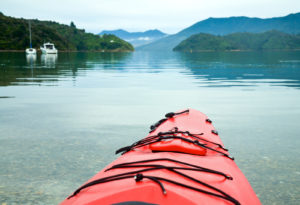What could be better than listening to natures tunes while enjoying some pristine scenic overlooks? Kayaking. Many of natures wonders lie secluded or hidden from plain site, and many times the only way to get there is by kayak. Kayaks are extremely durable in the fact that they can traverse tight water ways and even untravelable swamps. Their small “torpedo like” shape allows them to move very easily through swallow, or murky waters making even the toughest treks manageable.
So you might be asking what exactly do I need to become the next great kayaker? Well for starters you need a kayak that not only has enough length for your height, but also enough room to sit comfortably in, or on. You’ll also have to decide what type of kayak you’d like. The most common type you see these days is referred to as a touring kayak / recereational kayak, or one with a built in seat. The second isthe sit-on-top kayaks which resemble a flat surfboard. On the list of needs is also a paddle. There is no real rhyme or reason to this, but you’ll want to be sure its long enough on both ends to hit the water. So basically avoid the youth paddles if you’re an adult. The two biggest sources of safety are going to be your lifejacket, which by law is required on most bodies of water, and your bilge pump. A bilge pump or bailer is used to toss water out of your kayak should you roll over or spring a leak.
Now onto some safety tips when it comes to kayaking:
One should always be able to swim before trying out kayaking
One should plan your kayaking trip out in accordance with weather. Windy conditions make for dangerous kayaking conditions
One should always have a lifejacket on their person to prevent drowning if the kayak should roll over
One should practice, in a small pond or body of water, rolling and recoving in their kayak as its almost guaranteed to happen at some point as your kayaking
Kayaking can be as relaxing as is it challenging depending on the type person you are.
